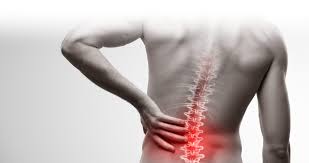Back pain & Spine disorder Hospital Lokapur

Back pain causes & treatment modalities
1. Degenerative Disc Disease (DDD)
Pathophysiology:
DDD occurs due to age-related wear and tear of intervertebral discs, causing reduced hydration and elasticity, leading to loss of disc height and structural integrity. This results in segmental instability and nerve root impingement.
Symptoms:
- Chronic, low-grade back or neck pain.
- Pain exacerbated by bending, lifting, or twisting.
- Possible radiating pain or tingling in limbs.
Diagnosis:
- Imaging: MRI shows disc desiccation, reduced height, or disc herniation.
- X-rays: Loss of disc height and possible osteophytes.
Treatment:
Non-surgical:
- Physical therapy (core strengthening).
- NSAIDs for inflammation and pain relief.
- Lifestyle modifications (weight loss, ergonomic adjustments).
- Intra-nuclear Ozonolysis: Involves ozone injection into the disc to reduce pressure and inflammation.
Surgical:
- Spinal fusion in severe cases.
- Artificial disc replacement for segmental preservation.
2. Spinal Stenosis
Pathophysiology:
Narrowing of the spinal canal or foramina due to hypertrophy of ligamentum flavum, osteophyte formation, or disc protrusion, leading to nerve compression.
Symptoms:
- Neurogenic claudication: Leg pain, numbness, and weakness relieved by flexion.
- Back pain.
Diagnosis:
- MRI: Gold standard for visualizing stenotic segments.
- CT: Useful for bony anatomy assessment.
Treatment:
- Non-surgical:
- Physical therapy and postural education.
- Epidural steroid injections for inflammation relief.
- Surgical:
- Decompression procedures (laminectomy or laminotomy).
- Fusion for instability.
3. Back Pain
Pathophysiology:
Can result from muscular strain, disc pathology, facet joint degeneration, or ligament injury.
Symptoms:
- Localized or radiating pain.
- Stiffness and reduced mobility.
Diagnosis:
- Clinical evaluation.
- Imaging if red flags (e.g., neurological deficits) are present.
Treatment:
- Non-surgical: Rest, physical therapy, and NSAIDs.
- Interventional: Epidural injections or nerve ablations for chronic pain.
4. Herniated Disc
Pathophysiology:
The nucleus pulposus protrudes through the annulus fibrosus, compressing nerve roots.
Symptoms:
- Radicular pain, numbness, or weakness in a dermatomal distribution.
Diagnosis:
- MRI: Gold standard for visualizing disc herniation.
Treatment:
- Non-surgical: Physical therapy, rest, and medications.
- Interventional:
- Selective Nerve Root Block (SNRB): Steroid injection targeting affected nerve roots.
- Microdiscectomy: Minimally invasive removal of herniated disc material.
5. Spondylosis
Pathophysiology:
Degeneration of the spine’s joints, discs, and ligaments, leading to bone spur formation and potential nerve root compression.
Symptoms:
- Chronic pain, stiffness, and potential radiculopathy.
Diagnosis:
- X-rays and MRI for structural and soft tissue evaluation.
Treatment:
- Non-surgical: Physical therapy, NSAIDs, and epidural steroid injections.
- Surgical: For refractory cases with significant neurological deficits.
6. Spondylolisthesis
Pathophysiology:
Anterior displacement of a vertebral body over the one below, often due to isthmic or degenerative changes.
Symptoms:
- Back pain, sciatica, or neurogenic claudication.
Diagnosis:
- X-rays (dynamic views for instability).
- MRI for nerve involvement.
Treatment:
- Non-surgical: Core strengthening exercises and braces.
- Surgical: Fusion or decompression for instability or neurological compromise.
7. Neck Pain
Pathophysiology:
Can result from muscle strain, disc degeneration, or facet arthropathy.
Symptoms:
- Localized pain and stiffness.
- Possible radiating pain into arms.
Diagnosis:
- Clinical and imaging (X-rays, MRI).
Treatment:
- Rest, physical therapy, and medications.
- Cervical epidural injections for chronic cases.
8. Spine Fracture
Pathophysiology:
Occurs due to trauma, osteoporosis, or metastatic disease, resulting in vertebral compression or instability.
Symptoms:
- Acute, localized pain.
- Potential neurological deficits.
Diagnosis:
- X-rays, CT for bony details, and MRI for soft tissue injury.
Treatment:
- Non-surgical: Bracing for stable fractures.
- Surgical:
- Vertebroplasty or kyphoplasty for osteoporotic fractures.
- Fixation for unstable fractures.
9. Scoliosis
Pathophysiology:
Lateral curvature of the spine with rotational deformity, often idiopathic or secondary to neuromuscular disorders.
Symptoms:
- Visible spinal asymmetry.
- Back pain in adults.
Diagnosis:
- Clinical exam and standing X-rays.
Treatment:
- Bracing in adolescents with progressive curves.
- Surgical correction for severe curves affecting function.
10. Cauda Equina Syndrome
Pathophysiology:
Compression of the cauda equina nerves, often due to a large disc herniation or trauma.
Symptoms:
- Saddle anesthesia, bowel/bladder dysfunction, and lower limb weakness.
Diagnosis:
- MRI for visualization of the compressive lesion.
Treatment:
- Surgical: Emergent decompression.
Interventional Pain Management Techniques
- Epidural Steroid Injections: Effective for radiculopathy; complications include infection, dural puncture, or steroid-induced side effects.
- Selective Nerve Blocks: Diagnostic and therapeutic.
- Facet Joint Injections and Radiofrequency Ablation: Effective for facet-mediated pain.
These modalities, combined with surgical and conservative approaches, provide comprehensive management tailored to patient-specific needs.